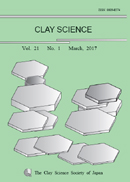
- 4 号 p. 55-
- 3 号 p. 31-
- 2 号 p. 19-
- 1 号 p. 1-
- |<
- <
- 1
- >
- >|
-
Masafumi Okawara, Yasuaki Saito, Kenichi Soga2019 年23 巻2 号 p. 19-24
発行日: 2019/06/28
公開日: 2019/07/16
ジャーナル フリーType Tests using small-angle X-ray scattering method were conducted to elucidate the mechanism of consistency in Na–montmorillonite. It is possible to analyze the particle structure at the nanometer level using the small-angle X-ray scattering method, which enables measurement exceeding basal spacing of 10 nm, which is not possible in XRD. Based on the test results, in the solid state to semi-solid state, there was crystalline swelling in which the molecular water layer thickness increased stepwise, whereas in the plastic state to liquid state, there was osmotic swelling in which the distance between particles continually increased. Moreover, near the plastic limit, the basal spacing increased rapidly from a 3-mol-thick water layer to a 12-mol-thick water layer; furthermore, as the liquid limit approached, the basal spacing increased up to the order of 50-mol-thick water layer. An evaluation of the orientation of the clay particles from the X-ray scattering images revealed that, while the particles were randomly oriented in the solid state to semi-solid state, they became oriented ordered in the plastic state. Furthermore, in the liquid state, it was observed that the particle orientation became random again.
抄録全体を表示PDF形式でダウンロード (871K) -
Teruyuki Nakato, Kanji Saito, Akira Ikeda, Yuki Higashi, Yasutaka Suzu ...2019 年23 巻2 号 p. 25-30
発行日: 2019/06/28
公開日: 2019/07/16
ジャーナル フリーOptical trapping of three oxide nanosheets prepared by exfoliation of layered lepidocrocite-type titanate, hexaniobate, and fluorohectorite was carried out by the irradiation of linearly polarized laser beam, and their trapping behavior was compared in relation to the refractivity of oxide nanosheets. All of the nanosheets showed similar two-stage trapping process in enough dilute colloids where single nanosheets with their area around 50–100 µm2 were trapped. The first stage was arrestment of a single nanosheet by the laser beam at the focus and orientation with its in-plane direction parallel to the propagation direction of the incident laser beam. The second stage was the rotation of arrested nanosheet with keeping the orientation parallel to the propagation direction of the laser beam to reach the alignment of nanosheet edge (longitudinal) direction in parallel to the polarization direction of the incident irradiation. Higher trapping efficiency, evaluated by trapping with weaker laser beam and shorter time for the completion of orientational change, was found for the nanosheet species with larger refractive index.
抄録全体を表示PDF形式でダウンロード (606K)
- |<
- <
- 1
- >
- >|